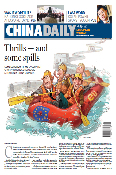Growth shifts to emerging nations
Updated: 2010-04-23 07:44
By Dan Steinbock (China Daily)
In March, China had its first monthly trade deficit in six years. The appreciation of the renminbi would not correct global imbalances. If anything, an excessive concern with the Chinese currency contributes to trade friction that can hurt all and benefit none.
In the past two years, policymakers have helped the world dodge a second Great Depression, but the bill is yet to be paid. At the same time, low interest rates and inventory-driven growth have masked troublesome trends in the advanced economies.
In the past, countries with very high budget deficits were in the developing world. Today, countries with very high deficits amount to more than 40 percent of global GDP. This figure is dominated by advanced economies such as the US and the UK. Since high debt levels tend to slow economic growth, the ratio does not bode well for the future.
In Western Europe, the Greek crisis is not an isolated case, but an inherent part of a vulnerable fabric, which has already led to significant deterioration in Iceland and Ireland, and threatens to include Portugal and Spain.
In the US, the rating agencies are taking a serious look at the doggedly high deficits and the debt-to-GDP ratio, which has increased some 20 percent in less than two years.
In the short term, substantial fiscal consolidation is not considered likely, due to the mid-term elections in November. Prospects of enduring growth are soft. In the first half of the year, the annualized growth rate may be 4-5 percent; in the second half, it may slow to 2 percent.
As a result, rising debt in the US could reach levels that are no longer compatible with a triple-A rating. Since a downgrade would increase borrowing costs, it would further weaken growth prospects.
We are living a period of dangerous complacency and elusive calm. In many advanced economies, the global crisis in the private sector has caused a rapid and huge deterioration in public finances.
With slowing growth in advanced economies coupled with higher growth potential in emerging economies, the worldwide impact is not cyclical, but structural.
When the dust settles after this crisis, many developed economies will look more impoverished, and many developing economies will look more developed.
At the heart of the world economy, the sources of global growth are engaged in a transition of historic significance - from the leading advanced nations to the large emerging economies.
Today, trade threats are the last thing legislators should contemplate in advanced economies. If would be wiser to adopt a longer perspective, and to build bridges rather than barriers - if only to participate in growth that could benefit all.
The author is research director of international business at the India, China and America Institute, an independent think tank in the US.
(China Daily 04/23/2010 page9)
Paper's Digest

Chinese jet takes on Big 2
First large commercial plane set to ride on demand for aircraft as economy grows.
Super-CPU only for domestic eyes
Specials

Gaining ground
Doing business in china for westerners has come a long way, Peter batey says.

Safeguarding environment a priority
China continues to face mounting pressure to curb environmental degradation, despite progress in reducing pollution over the last five years, the environmental protection minister warned.

Employment to remain a continuing challenge
China's top labor official said the country will face a tough employment situation in the next five years.
